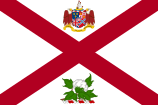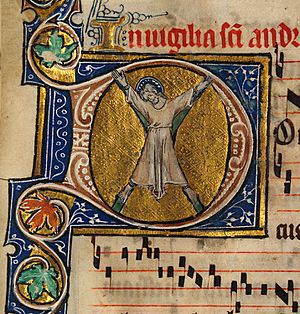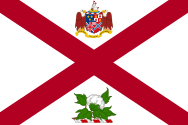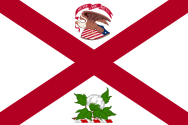Flag of Alabama facts for kids
 |
|
| Proportion | 2:3 |
|---|---|
| Adopted | February 16, 1895 |
| Design | Crimson cross of St. Andrew on a field of white |

Variant flag of Alabama
|
|
| Name | Flag of the Governor of Alabama |
| Design | The State Flag with the state military crest and Coat of Arms of Alabama in the lower and upper sections |
The flag of Alabama is the official symbol of the U.S. state of Alabama. It was adopted on February 16, 1895. The flag shows a red diagonal cross, called a "saltire" or "cross of St. Andrew," on a white background. This design is meant to look like the cross on which Saint Andrew was crucified.
The law that created the flag says the red bars of the cross must be at least six inches wide. They must also go diagonally from one corner of the flag to the opposite corner. Some people think this design was chosen to remember the Confederacy, but there are no official records that say why it was picked.
Contents
History of the Alabama Flag
Alabama's First Flag (1861)
Alabama had an earlier official flag. It was chosen on January 11, 1861, by the Alabama Secession Convention. Several women from Montgomery, Alabama, helped design it. Francis Corra of Montgomery added the final touches.
One side of this flag showed the Goddess of Liberty. She held a sword in one hand and a small blue flag with one gold star in the other. Above the star, it said "Alabama." Above the goddess, it read "Independent Now and Forever."
The other side of the flag had a cotton plant and a coiled rattlesnake. Below the plant, it said "Noli Me Tangere," which means "Touch Me Not" in Latin. This flag was sent to the governor's office in February 1861. However, it was damaged by bad weather and was never flown again.
The Current Flag (1895)
Alabama's current flag was adopted in 1895. A politician named John W. A. Sanford Jr. suggested the design. He said the flag should have a red cross of St. Andrew on a white background. The cross bars had to be at least six inches wide and stretch diagonally across the flag.
Sanford's father had been a commander in the Civil War. He based his design on a battle flag used by his father's regiment. That flag had a white diagonal cross on a blue background. It also had a circle of white stars. This battle flag was carried by soldiers until the end of the war.
The diagonal cross on Alabama's flag looks a lot like the cross on the flag of Florida. Florida's flag design comes from the Spanish Cross of Burgundy. This cross was used in southern Alabama a long time ago when it was part of Spanish territory.
Some people think Alabama's red diagonal cross was meant to look like the blue diagonal cross on the Confederate Battle Flag. Many battle flags were square, and sometimes Alabama's flag is shown as square too. However, the law that created the flag did not say it had to be square. In 1987, the state's Attorney General said the flag should be rectangular. Even so, it is still often shown as square.
Historian John M. Coski noted that Alabama's flag was adopted around the same time as Jim Crow laws. These laws created unfair rules and segregation, which meant people were kept separate based on their race. Other Southern states, like Mississippi and Florida, also adopted new flags based on Confederate designs during this period.
Governor's Flag
The flag for the Governor of Alabama is a special version of the state flag. It has the state flag's design, but with added symbols. In the top part of the diagonal cross, it shows the state's coat of arms. In the bottom part, it has the state's military crest. This crest shows a cotton plant with a full, open cotton boll.
|
|
Images for kids
-
The Alabama state flag displayed at Ivy Green, Helen Keller's birthplace in Tuscumbia
See also
 In Spanish: Bandera de Alabama para niños
In Spanish: Bandera de Alabama para niños










